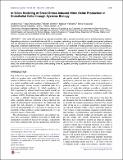In Silico Modeling of Shear-Stress-Induced Nitric Oxide Production in Endothelial Cells through Systems Biology
Author(s)
Koo, Andrew Jia-An; Nordsletten, David; Umeton, Renato; Yankama, Beracah; Ayyadurai, V. A. Shiva; Dewey, C. Forbes; Garcia-Cardena, Guillermo; Dewey, C. Forbes; ... Show more Show less
DownloadKoo-2013-In Silico Modeling o.pdf (1.742Mb)
PUBLISHER_CC
Publisher with Creative Commons License
Creative Commons Attribution
Terms of use
Metadata
Show full item recordAbstract
Nitric oxide (NO) produced by vascular endothelial cells is a potent vasodilator and an antiinflammatory mediator. Regulating production of endothelial-derived NO is a complex undertaking, involving multiple signaling and genetic pathways that are activated by diverse humoral and biomechanical stimuli. To gain a thorough understanding of the rich diversity of responses observed experimentally, it is necessary to account for an ensemble of these pathways acting simultaneously. In this article, we have assembled four quantitative molecular pathways previously proposed for shear-stress-induced NO production. In these pathways, endothelial NO synthase is activated 1), via calcium release, 2), via phosphorylation reactions, and 3), via enhanced protein expression. To these activation pathways, we have added a fourth, a pathway describing actual NO production from endothelial NO synthase and its various protein partners. These pathways were combined and simulated using CytoSolve, a computational environment for combining independent pathway calculations. The integrated model is able to describe the experimentally observed change in NO production with time after the application of fluid shear stress. This model can also be used to predict the specific effects on the system after interventional pharmacological or genetic changes. Importantly, this model reflects the up-to-date understanding of the NO system, providing a platform upon which information can be aggregated in an additive way.
Date issued
2013-05Department
Massachusetts Institute of Technology. Department of Biological Engineering; Massachusetts Institute of Technology. Department of Mechanical Engineering; Massachusetts Institute of Technology. Laboratory for Information and Decision SystemsJournal
Biophysical Journal
Publisher
Elsevier
Citation
Koo, Andrew, David Nordsletten, Renato Umeton, Beracah Yankama, Shiva Ayyadurai, Guillermo Garcia-Cardena, and C. Forbes Dewey. “In Silico Modeling of Shear-Stress-Induced Nitric Oxide Production in Endothelial Cells through Systems Biology.” Biophysical Journal 104, no. 10 (May 2013): 2295–2306. © 2013 Biophysical Society
Version: Final published version
ISSN
00063495